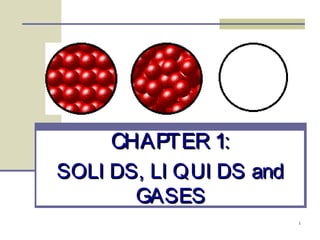
Chapt 1 kpt of solids, liquids & gases (1)
- 1. CHAPTER 1: SOLI DS, LI QUI DS and GASES 1
- 2. WHAT WE WILL BE LEARNING Describe the arrangement and properties of solid, liquid & gaseous states of matter using Kinetic Particle Theory Explain the inter- conversion of the 3 states of matter in terms of Kinetic Particle Theory and of the energy changes. 2
- 3. WHAT IS MATTER MADE OF ? Matter is anything that occupies space and has mass. • It can exist as a solid, a liquid or a gas. Recall : 1) Solids • It has a definite shape and volume. 3
- 4. 2) Liquids • It has a definite volume but no definite shape. • It takes the shape of the container. 3) Gases • It has no definite shape and volume. • It can be compressed and take the shape of the container. 4
- 5. KINETIC PARTICLE THEORY The differences in the properties of solids, liquids and gases can be explained in terms of the Kinetic Particle Theory. Theory • This theory states that all matter is made up of tiny particles and are always in constant random motion. 5
- 6. 1) Solids • The particles are packed very closely together in a fixed, regular pattern. pattern This is why crystals have flat faces, straight edges and sharp points. • The particles attract one another strongly, thus they are in strongly fixed positions. This gives solid a definite volume and a definite shape. 6
- 7. • The particles are not free to move about but can only vibrate gently about their fixed positions. positions This is why solid cannot be compressed. • There is very little empty space between the particles. This is why solid has high density. 7
- 8. 2) Liquids • The particles are packed closely together, but together not as close as those particles in solids. This explains why liquid cannot be compressed. • The particles are held together by forces of attraction between them. This explains why liquid has a definite volume. 8
- 9. • The particles are not arranged in a fixed pattern and they are free to move about within short distances (in between each other and throughout the liquid). This is why liquid has no definite shape. They flow and take the shape of the container. 9
- 10. 3) Gases • The particles are far apart from each other and there is so much space between each particle. particle This explains why gas can be compressed easily and has low density. • The particles have little attraction for one another. This explains why gas has no definite volume. 10
- 11. • The particles are not arranged in a fixed pattern and they move about randomly. randomly • They can spread out rapidly to fill up a container. This is why gas has no definite shape. 11
- 12. CHANGES OF STATES Matter can change its state. • This change in state is reversible. reversible Process Changes from … Brief Description Melting solid to liquid Heating causes particles in the solid to vibrate more until they break free from their fixed position. Boiling/ liquid to gas Heating causes particles in the liquid to gain energy to move faster and further apart. Eventually they break away from surrounding particles and form gas. Vaporization 12
- 13. Process Changes from Brief Description Condensation gas to liquid Energy is removed from the gas particles. This causes them to slow down and enter the liquid state. Freezing liquid to solid Particles lose heat, slow down and get locked into position. Sublimation Solid to gas Solid changes into gas without going through the liquid state. 13
- 14. I ) Melt ing Melting is a process in which a solid changes into a liquid. Heat is absorbed during melting. Melting takes place at a fixed temperature called the melting point. point temperature stearic acid water at 100ºC 14 HEAT
- 15. Heating curve for changing a Solid to a Liquid Temperature /oC Melting completes Melting starts Melting Point of Substance Solid + Liquid Solid Liquid Time /min 15
- 16. II) B oiling Boiling is a process in which a liquid changes into a gas. gas This change in state occurs inside the liquid. liquid Heat is absorbed during boiling. Boiling takes place at a fixed temperature called the boiling point. point 16
- 17. Heating curve for changing a Liquid to a Gas Temperature /oC Boiling completes Boiling starts Boiling Point of Substance Liquid + Gas Liquid Gas Time /min 17
- 18. I V) Sublimat ion Sublimation is a process in which a solid changes into a gas without passing through the liquid phase. phase Heat is absorbed during sublimation. Sublimation takes place at a fixed temperature. Examples: Dry ice, iodine, ammonium chloride 18
- 19. V) Condensat ion Condensation is a process in which either a gas changes into a liquid or a gas changes into a solid. solid This change in state occurs when a gas is cooled to its boiling point. Heat is evolved during condensation. Condensation takes place at a fixed temperature numerically equal to its boiling point. 19
- 20. Cooling curve for changing a Gas into a Liquid Temperature /oC Condensation starts Boiling Point of Substance Gas Condensation completes Liquid + Gas Liquid Time /min 20
- 21. VI ) Fr eezing Freezing is a process in which a liquid changes into a solid. solid Heat is evolved during freezing. Freezing takes place at a fixed temperature called the freezing point. point Freezing point and melting point have the same numerical value. 21
- 22. Cooling curve for changing a Liquid into a Solid Temperature /oC Freezing starts Freezing Point of Substance Freezing completes Liquid Liquid + Solid Solid Time /min 22
Notes de l'éditeur
- Give illustration of how dry ice is used in refrigeration (pg 11, chem matters ttbk)
